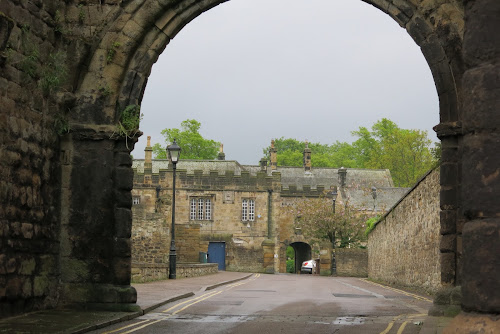
It was very evocative as a strong sea mist came in as we walked along the beach. It felt like a living creature as this cold, damp mist swirled around
The castle stands on an almost perpendicular piece of rock

It is on a site of one of a chain of fortresses built by the Romans. It may have been the capital of the British kingdom of the region from the realm's foundation in c.420 until 547, the year of the first written reference to the castle. In that year the citadel was captured by the Anglo-Saxon ruler Ida of Bernicia and became Ida's seat. It was briefly retaken by the Britons from his son Hussa during the war of 590 before being relieved later the same year.
His grandson passed it on to his wife Bebba, from whom the early name Bebbanburgh was derived. The Vikings destroyed the original fortification in 993.
The Normans built a new castle on the site, which forms the core of the present one. William II unsuccessfully besieged it in 1095 during a revolt supported by its owner, Robert de Mowbray, Earl of Northumbria. After Robert was captured, his wife continued the defence until coerced to surrender by the king's threat to blind her husband.
Bamburgh then became the property of the reigning English monarch. Henry II probably built the keep. As an important English outpost, the castle was the target of occasional raids from Scotland. In 1464 during the Wars of the Roses, it became the first castle in England to be defeated by artillery, at the end of a nine-month siege by Richard Neville, 16th Earl of Warwick.
The castle deteriorated but was restored by various owners during the 18th and 19th centuries. It was finally bought by the Victorian industrialist William Armstrong, who completed the restoration.
Being half term holidays there were lots of families on the beach and sounds of laughter circled within the mists.
Then it was onto Lindisfarne. This is an island much of the time so you have to be sure of the time and tides before driving over to it. Again the sea mists played around the edges of the land. Very evocative for a Holy Island!
In 654 St Cuthbert came to Lindisfarne as the fifth successor to Bishop Aidan.In 793 A.D Lindisfarne was to witness the first Viking raid on the coast of Britain.
Inside the old church next to the Abbey ruins
Geoff is on a quest to see Saxon churches which are intact so we set off to see Bede's monastery at Jarrow. We had to navigate through the centre of Newcastle to get there which was a bit of a challenge although the mighty Ipad did brilliantly. When we got there we couldn't get in however as it had just closed which was disappointing. We did however see the outside of the original parts which was good.

















































